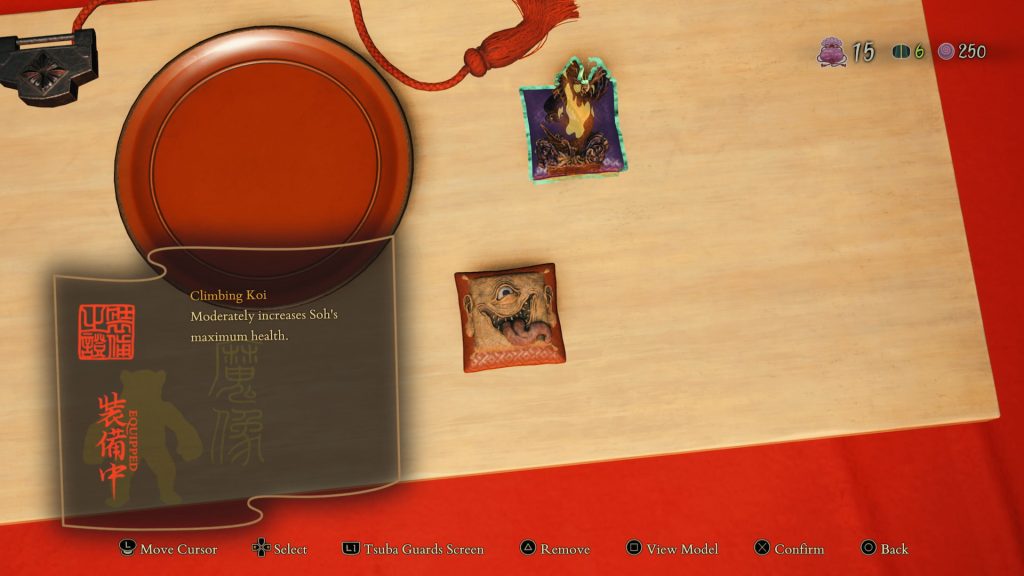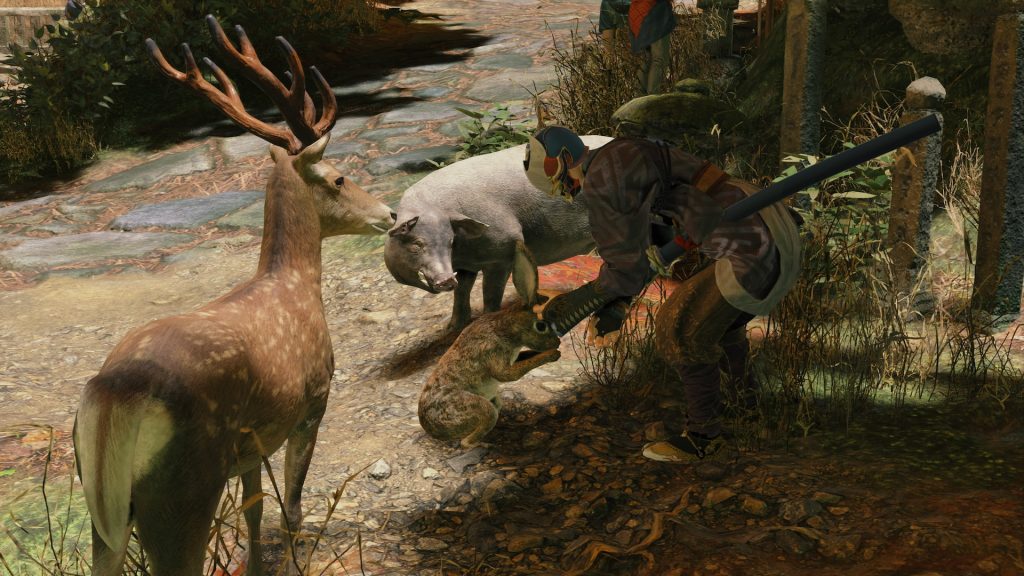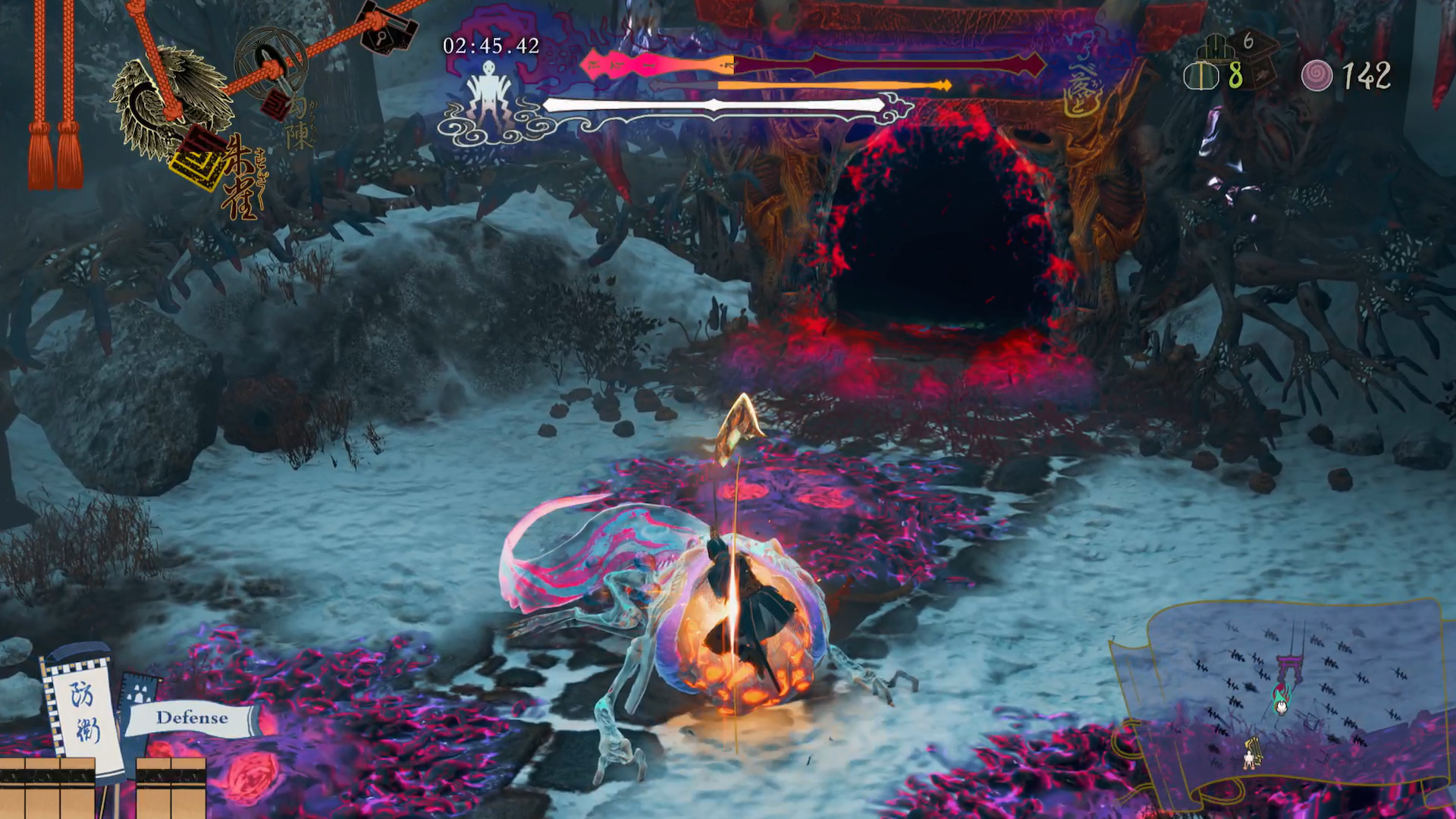Kunitsu-Gami is an action/strategy game with a simple, yet satisfying structure, and it’s made by Capcom’s Division 1 team no less. The game consists of three phases: the preparation phase, combat phase, and then a relaxed rebuild one after that. Those are the three parts of Kunitsu-Gami’s gameplay, but the whole experience certainly shines above each of them. The basic premise of Kunitsu-Gami revolves around the maiden, Yoshiro, purifying Mt. Kufaku’s demonized villages with the help of her trusty swordsman, Soh. You control Soh as you purify and command villagers to fight off the demonic Seethe. I appreciate how clear the outline of this game is. You’re shown exactly what needs to be done right from the get-go; reclaim the 11 Masks and purify the villages across the mountain. It’s a premise that’s easy to get behind, with plenty of surprises along the way.
One of my favorite things about Kunitsu-Gami is how balanced an experience it is. You always feel like you’re doing different activities, never lingering on any one of them for too long thanks to the three-phase structure. Purifying the villages of Mt. Kufaku first requires you to rescue villagers and use resources to assign them roles, which in turn help you combat the Seethe at night. But before going further, let’s go over the most basic part of the game everyone wants to know about: the combat and controls.
Kunitsu-Gami is a blend of hack-and-slash action and strategy. It’s not an either/or hybridization either, both styles are seamlessly integrated throughout the gameplay. The sword-fighting in this game feels decent enough, but the stiff attack inputs and basic combos keep it from being truly excellent. A lock-on function could’ve helped mitigate the stiff execution of attacks a bit, but there’s only so much you can do when inputs and animations can’t be canceled mid-execution, as is the case here. One thing that could’ve been mitigated, however, is the basic moveset that Koh is limited to during the early portions of the game. Maybe it’s because I attempted to clear the optional objectives of the village levels multiple times, but I just felt restricted in what I could do as Soh … well, until I unlocked his skill tree.
“You don’t unlock Soh’s skill tree until a decent way into the game’s narrative”
You see, Soh actually does have an expanding skillset; you just don’t unlock it until you purify the sixth village. Once you unlock Soh’s skill tree, you can access parry, quick attack, arrows, stun execution, streamlined strategy commands, and additional combos by way of new sword forms. Yeah, that’s a whole lot of kit entirely missing from the first half of the game. While Soh’s skill tree does arrive a bit too late in the game, the existence of new game+ and the length of the second half make good use of the abilities. Still, a total lack of progression for the main character throughout the entire first half of the game is strongly felt, especially since some of the abilities are basic features that should’ve probably been available from the beginning. But this game doesn’t just revolve around your own sword-fighting ability, there’s a host of villagers hankering to join your quest to purify Mt. Kafuku.
This is where Kunitsu-Gami‘s strategy element comes in. In order to make use of the villagers, you first have to rescue them and assign them roles. You unlock villager roles (or classes) as you gather the game’s 11 masks. Each role requires a different amount of crystal currency, so it’s a process that requires some managerial skill. Do you want a smaller group of expensive specialized Ascetics at the cost of unit quantity? Or, would you rather just have a large army of basic Woodcutter units? There’s even a unit specially made just to locate and dig up treasure buried across the village. You accumulate crystal resources by purifying parts of the village, getting rewarded with a useful skill Talisman for successfully purifying the village to 100%. But of course, there’s a time limit. Once nighttime arrives, you must stop resource-gathering and protect the maiden, Yoshiro.
Commanding units is a simple affair. You just pull up the units menu and place each one where they will stand and they’ll automatically attack enemies. But here’s where another of my criticisms comes in. There’s no way to gather every unit collectively in a single space. Well, not until you unlock Soh’s skill tree after purifying the sixth village. Yes, basic commands and convenience features are also locked within Soh’s skill tree, which just makes it even more baffling why it’s pushed so far into the game. I also feel like your command circle is too small, requiring you to manually hoof it to locations where you wish to place units instead of some kind of expansive top-down grid. Anyway, I do enjoy the strategy element in this game despite these small irritations. It’s fun to strategically place units and choose defensive or offensive positions for your army of villagers. The creative level design makes strategic planning even more fun and varied.
“Boss fights are fun and varied and each includes a list of challenges and rewards”
The levels (or unpurified villages) are wonderfully varied, each having a unique gimmick. For example, one stage prevents you from attacking enemies as Soh, instead forcing you solely into the commander role. Other levels take place in dark caverns, requiring you to light torches and plan your units around lighted areas so they don’t get lost. I can go on, but you get the idea. Just about every single stage has some interesting twist that keeps gameplay fresh and engaging.
That same level of creativity is present in the boss fights of Kunitsu-Gami. Boss fights require interesting strategies, rarely ever devolving into repetitive hack-and-slash gameplay. Each boss has a unique gimmick that compels you to use your units and abilities in different ways. You’ll fight bosses with weak points that specific units like long-range archers can exploit. Some bosses flop around dealing status ailments across wide areas, and there’s even one later on that feels like a 1-on-1 sword duel against a souls-like boss.
You still have command over your villagers during boss fights, with more generic ‘defend’ and ‘fight’ commands. Some of the bosses that employ mobs especially require you to monitor Yoshiro’s status at all times, and simplifying the commands to a universal ‘defend Yoshiro’ is an elegant solution to that. Stage and boss designs are wonderfully varied, putting both Soh’s individual combat and command of the villagers to good use equally. Additionally, each stage and boss battle has a set of optional challenges that you can tackle, some of which require specific units or Talismans to achieve. Oh yeah, that brings me to equipment.
You can sort through your equipment at the various villages you’ve purified. These purified villages are also where you’ll send villagers on construction projects to rebuild said village into a completed state. Soh’s equipment and host of collectibles can be sorted inside Yoshiro’s tent, which is where you equip Talismans and Guards. First, let’s talk about Guards. Guards are Soh’s special ‘active’ skills. You start with one equippable Guard but get more slots as you upgrade Soh’s skill tree (again, unlocked much later).

“Talismans and Guards provide you with lots of skills and buffs to experiment with”
While Guards fulfill a more active role, Talismans function as passive buffs. There’s a wide variety of Guards and Talismans available in the game, allowing for multiple build possibilities. Some Talismans don’t even have combat benefits, such as the one that has villagers greet Soh. Nothing gets across the sheer number of Talismans in the game quite so well as scrolling through them yourself. It’s way more irritating than it needs to be to find a specific Talisman in your inventory. You can jump through categories, sure, but there’s no quick-scroll or way to scroll by increments. There’s a total of 72 Talismans in Kunitsu-Gami, which is great for build variety, but not so great when you’re cumbersomely scrolling through them one by one to find what you want.
Once you’re finished sorting your equipment, you’ll notice there are lots of fun things to check out in the purified villages. Sending villagers on construction jobs rewards you with crystal currency, rations used for battles, and neat collectibles in the form of confectionaries. Confectionaries don’t serve a practical function in the game, serving more as flavor lore for their real-world counterparts and something for Yoshiro to eat in her tent (yes, really). You can even zoom in on these sweets and rotate their models, which, by the way, look absolutely great in the RE engine. Talismans and Guards can also be examined and rotated as well.

“You can pet animals, fix buildings, and collect a variety of sweets within the purified villages”
There’s a simple delight in giving Yoshiro sweets, petting animals, and completing construction jobs. These calm rebuilding sections allow you to really reap the rewards of combating the Seethe, making it feel like you’re truly helping the villagers. Each villager has their own unique background text, so you can feel that sense of community even more sharply. Oh, and the calm Einaudi-esque piano music wafting about as you pet bunnies and deer just puts a bowtie on the whole thing. Very few games have a positive feedback loop as strong Kunitsu-Gami’s purified village moments.
To tie back into the start of this review, Kunitsu-Gami has a very enticing balance to it that keeps any one element from feeling stale. The prepare, fight, and rebuild phases of the game make it a unified experience quite unlike any other. The game takes about 20 hours to complete, but you may find yourself wanting to collect everything and doing the extra challenges just because you want to see all the villages rebuilt and Yoshiro with a complete roster of sweets. Kunitsu-Gami is certainly one of those games where the whole is greater than its parts, making the small irritants a little more forgivable in the end.
This game was reviewed on the PlayStation 5.


